by TRA
Using the macro lenses on the
Exakta 66 bellows
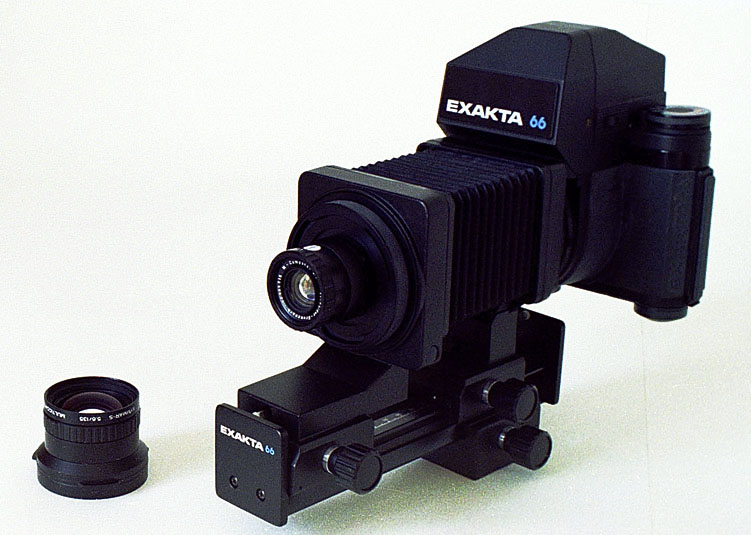
[C404-18] Exakta 66 camera and bellows, with M – Componon f4/50mm on
the bellows
and Symmar – S f5.6/135mm beside it
|
by TRA Using the macro lenses on the
Exakta 66 bellows
|
|
Infinity focus The original Exakta 66 12-page publicity brochure, produced in 1986, states: |
“Schneider Symmar-S 5.6/135 mm and Schneider Symmar-S 5.6/180 mm may both be focused from infinity to quite close in one smooth turn.” – underlining theirs! |
| This certainly should be possible. After all, these lens were
designed for use with 5×4” cameras, where the distance between the
front lens board and the film plane is normally substantially greater than
in Medium Format cameras. However, on such cameras the lenses are
mounted in a shutter mount that has its own aperture, one half of the lens
being in front of the shutter and aperture, and the other half being behind
it, recessed within the bellows of the 5×4 camera. To use these
lenses on the Exakta 66, the two halves of the lens are removed from the
shutter mount and mounted by Schneider in an aperture housing (Schneider’s
German term for this: Blendenkörper), to which an Exakta 66 mount
is added at the back.
However, when the resultant lenses are mounted on the Exakta 66 bellows, infinity focus is not possible! A prototype, at least, of the Exakta 66 bellows had already been made in 1986 – it is illustrated in the accompanying photograph, and it looks just the same as the bellows that went into serial production. However, the Exakta 66 aperture housings for the Symmars and the mounts for all four lenses had obviously not been produced, and the photograph shows instead the standard Xenotar lens mounted on the bellows. Further, the sketches – there are no photographs! – of the lenses on page 11 of the brochure show the Symmars and the Componons in their standard mounts for use on 5×4 lens boards and enlargers, respectively, without the aperture housing for the Symmars nor the Exakta 66 mount for either type of lens. The instruction manual for the Exakta 66 repeats the incorrect information in the 1986 brochure (or the brochure repeats the information in the manual…). I have only the German version of the manual, which says: |
“Die Objektive SYMMAR-S 5,6/135 mm und SYMMAR-S 5,6/180 mm können von Unendlich bis in den Nahbereich hinein verwendet werden.” (My translation: “The SYMMAR-S 5.6/135mm and SYMMAR-S 5.6/180 mm lenses can be used from infinity to close up.”) |
| The version of the manual supplied with the Exakta 66 Mk II from 1990
onwards does not correct this error (although the incorrect statement in
the original manual that the 2× converter can be used with the 80mm
Xenotar has been crossed out with a felt tip! – whether by the manufacturer
or the previous owner I do not know).
The 1990 Exakta 66 brochure does show all four of these lenses in photographs, but all references to the Symmars focussing to infinity have disappeared. Also it is clear that the Exakta 66 mounting ring on the 28 mm M Componon has been put on back to front(!), while the 50mm Componon does not have an Exakta 66 mounting ring fitted, so the brochure producer who set up the photographs obviously didn’t try to mount the Componons onto anything at all! This brochure just copies the information on these lenses from the 1986 brochure, including the mistakes (look at the weights of the lenses!). The correct weights are in the camera user’s manual. |
| Interestingly, none less than Hasselblad had exactly
the same problem: the 135mm f5.6 S-Planar lens that was introduced in 1967
was designed for use with the bellows unit only, with which it was intended
to achieve infinity focus. However, if the bellows unit then available
was used (the original square bellows unit, ref 40134), infinity focus
was not possible, as the bellows had a minimum extension of 3 inches (76mm),
and the lens needs a minimum extension of only 2½" (64mm) to obtain
infinity focus. This problem was corrected the following year with
the introduction of the round bellows (40223). This had a minimum
extension of 2½".
It is regrettable that Exakta GmbH did not carry out a similar re-design. Perhaps they were aware that using the Pentacon Six bellows would solve the problem? |
| Does it matter that infinity
focus is not possible?
Well, if you are just copying postage stamps or documents, no. But if you plan a visit to a wildlife park, a zoo, a flower show or a bird sanctuary, you may appreciate the possibility of taking general views at infinity focus at one minute, and extreme close-ups at the next, without having to change lenses. Of course, none of these lenses offer auto aperture control, so you have to open up to focus and stop down to meter and fire. The clever aperture stop-down mechanism on the Exakta 66 bellows only works with the non-macro lenses. Symmar – S 5.6/135 The extension required to achieve infinity focus with this lens is 45mm. However, the minimum extension of the Exakta 66 bellows unit is 66 mm, so this lens does not focus to infinity when mounted on an Exakta 66 via the Exakta 66 bellows unit. This is a clear example of lack of co-ordination between the designers of the aperture housing for the Symmar lenses and the team that designed the bellows. |
| The furthest away that can be focussed with
the Symmar-S 5.6/135mm lens with the bellows on minimum extension
is approximately 91cm from the front of the lens. There is no realistic
chance of objects at infinity being acceptably sharp even at the minimum
aperture of f/45.
At this maximum possible distance from the object (minimum bellows extension), the object field visible in the viewfinder with the metering prism fitted is approximately 26.5cm × 26.5cm (approximately 10¼ × 10¼ inches in “old money”). However, the viewfinder – especially with the metering prism! – does not show the full image recorded on the film; the actual image field is 33cm × 33 cm (approximately 13” × 13”). See section at the end of the next page on “Relationship between viewfinder image and image on film, print or screen” (scroll down). Infinity focus can of course be achieved with two 22.5 mm extension tubes or the 30 mm and 15 mm tubes, but obviously with this set-up nothing closer than infinity can be brought into focus. With the bellows at maximum extension, the object field visible
in the viewfinder is approximately 5cm × 5cm – that’s about 2
in × 2 in– very small! The object focussed on is then about
26 cm from the front of the lens.
Image to the right:
|
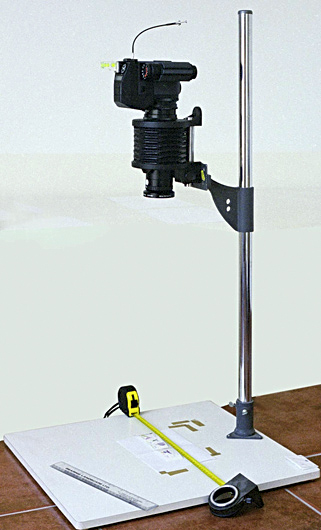 |
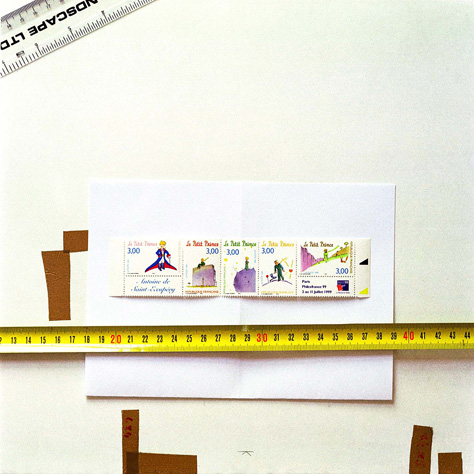
Symmar – S f5.6/135mm on Exakta 66 bellows at minimum extension f/14 |
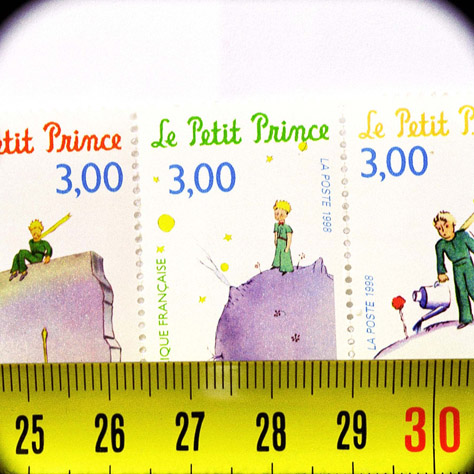
Symmar – S f5.6/135mm on Exakta 66 bellows at maximum extension f/14 |
| It is obviously possible to photograph smaller objects and focus closer to the subject with this lens by combining the bellows and extension tubes. |
| Vignetting
All images taken with the Exakta 66 bellows on maximum extension reveal a very small amount of vignetting which is however quite marked. I expect that this arises from the geometry of the bellows and camera throat and is not caused by the lenses. At maximum bellows extension, the path of the image rays is straighter, and clearly either the camera throat itself or something on the bellows vignettes the corners. In practice, this is not a serious problem, as part of the image on the film is in any case masked when printing or mounting in slide masks. However, perhaps it is an indication of the age of the Exakta 66 design, which essentially goes back 30 years before the launch of this camera, to the KW Praktisix that was first manufactured in 1956. This body was never designed to work with these lenses nor these bellows. To be fair to Schneider, their technical paper on the M – Componons says: |
“To ensure perfect coverage of the negative size, allowances should, however, be made for … any mechanical components that may possibly obstruct the light path in the camera.” |
| This comment obviously also applies to the Symmars when used on the
Exakta 66 bellows.
However, if the square image is to cropped to a rectangle, the small amount of vignetting even at 167 mm with the Exakta 66 bellows at full extension is easily lost. |
| Symmar – S 5.6/180
The 180mm Symmar achieves infinity focus with an extension of 61.5 mm, 4.5 mm less than the minimum extension of the Exakta 66 bellows. In fact, the lens very nearly focuses to infinity when used on the Exakta 66 bellows at minimum extension on the Exakta 66 – probably close enough for satisfactory results at apertures of f/8 or f/11 or smaller (it stops down to f/45, but you’ll need a lot of light and/or a very fast film to use this aperture, unless the object is not moving and you have the option to use a very slow shutter speed). Objects 15-20 metres or yards away can comfortably be focussed on. With the bellows at maximum extension, the object field visible in the viewfinder is approximately 7.8cm × 7.8cm – that’s about 3 1/8 in × 3 1/8 in. The object focussed on is then about 46 cm (about 18 1/8 inches) from the front of the lens – a comfortable distance that is unlikely to cause the camera to cast shadows onto the subject and is also less likely to alarm some subjects, such as insects and butterflies. |
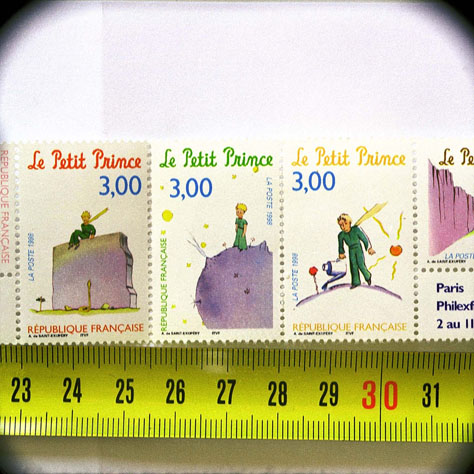
Symmar – S f5.6/180mm on Exakta 66 bellows at maximum extension f/14 (As the focus at minimum bellows extension was nearly infinity but not quite, no test image was taken at that setting) |
|
Two Schneider M – Componon lenses are available in Exakta 66 bellows mount, the 28mm and the 50mm. They are designed to give the maximum possible magnification of tiny objects, and in consequence it is not intended that either of them should focus to infinity when mounted on the bellows. The M or Macro Componons are in fact the top-of-the-range Schneider enlarging lenses, mounted in reverse in the mount in order to give the best-possible resolution. M – Componons have been available for many years in mounts for a range of quality cameras and are highly regarded for the results that they can deliver. These two lenses have a rear thread of 29.5mm × 0.5, to which the Exakta 66 mount ring can be simply added. M – Componon 4/28mm This is a specialist lens for copying the tiniest objects. On the Exakta 66 bellows at minimum extension, this lens renders on film an image four times life size. With these bellows at maximum extension, it renders on film an image eight times life size. With enlargements even of modest size (for instance, 5" square), the original is massively enlarged. As will be visible from the table and the accompanying illustrations, the sizes of items that can be photographed are tiny, and distances from the front of the lens to the object being photographed are very small. This can cause problems illuminating the object, and this lens may be best used with transparent objects, such as microscope slides illuminated from behind. Achieving accurate focus with this lens is difficult for two reasons:
|
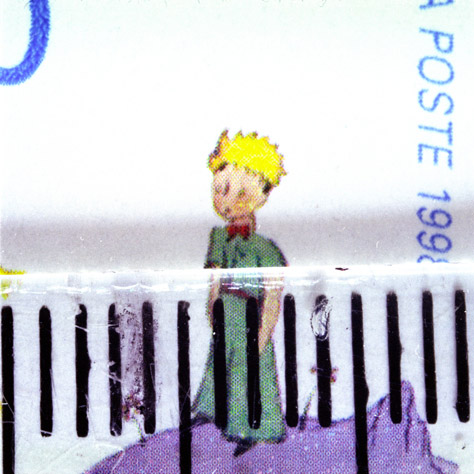 |
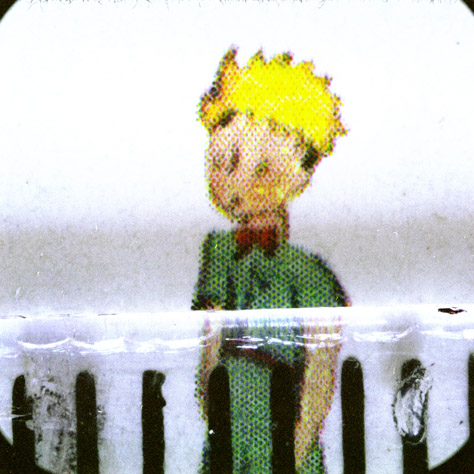 |
||
|
at minimum extension 18 sec f/14 [C472-7] |
at maximum extension 20 sec f/14 MLU [C472-6] |
| Note that the plastic ruler that was added to measure the width of field has cast a shadow on the middle section of these images. I should have compensated for light loss at maximum bellows extension and increased the exposure considerably. Note the slight vignetting at maximum extension with the 28mm M – Componon on the Exakta 66 bellows. |
| M – Componon 4/50mm
When this lens is mounted on the Exakta 66 bellows at minimum extension, the object field visible in the viewfinder is approximately 22mm × 22mm (just under 1 inch square) and the distance from the front of the lens to the object is approximately 6.3 cm. With this lens even a considerable increase in bellows extension requires only a small amount of movement forward to refocus the image. Thus, at maximum bellows extension, the object field visible in the viewfinder is approximately half linear (one quarter area) that at minimum extension: 11mm × 11mm, and the front of the lens is approximately 5.6 cm from the object. It is difficult to go a lot closer to the object, as the front of the bellows track projects about 24mm (1”) forward of the front of the lens. However, by using extension tubes instead of the bellows (or – in this case only – on the front of the bellows) it is possible to get closer still to objects and photograph a correspondingly smaller field. In such cases, great care needs to be taken with the lighting, so that the equipment does not cast shadows on the object to be photographed. However, for microscope slides or other items illuminated by transmitted instead of reflected light, this is not a problem. It is of course also possible to use this lens with the Pentacon Six bellows, with their much shorter extension (subject to the limitations explained above), with one of the tubes (15 mm, 22.5 mm, 30 mm or 60 mm) or even directly on the camera body. As with all macro work, precise focus is achieved by moving the camera backwards and forwards, best of all using a focussing rail mounted on a tripod, or by using a copying stand for flat originals. |
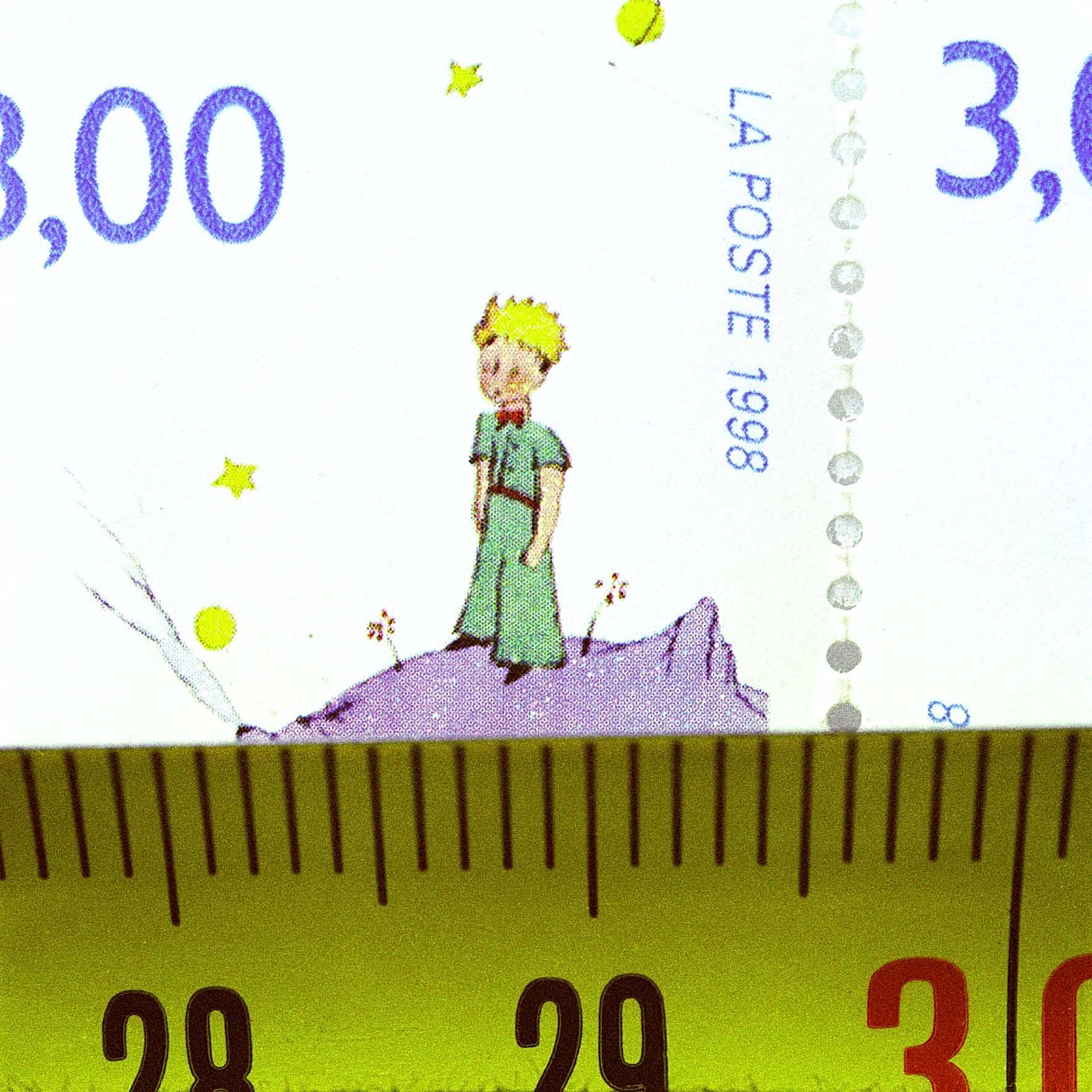 |
 |
||
|
at minimum extension f/14
|
at maximum extension f/14 This one is not sharp; I think that the stamp moved up out of the very narrow plane of focus either before or during the exposure. Also, the steel rule is not flat and is higher than the stamp. |
| All of the above information is summarised in the following table, which also includes the reproduction ratios. |
| Lens | Exakta 66 bellows
extension |
Approximate width of | object field | Reproduc-
tion ratio (2) |
Approximate
distance from |
| (min = 66 mm;
max = 167 mm) |
in viewfinder with prism | on film (1) | front of lens
to Object |
||
| Symmar – S
5.6/135 |
Minimum | 26.5 cm
(approx 10¼ in) |
33 cm | 0.17:1 | 91.2 cm
(approx 35 7/8") |
| Maximum | 5 cm
(approx 2 in) |
6 cm | 0.93:1 | 26.2 cm
(approx 10 3/8") |
|
| Symmar – S
5.6/180 |
Minimum | – | – | – | nearly infinity |
| Maximum | 7.8 cm
(3 1/8 in) |
9.6 cm | 0.58:1 | 46 cm
(approx 18 1/8") |
|
| M – Componon
4/28mm |
Minimum | 1.2 cm
(approx 7/16") |
1.4 cm | 4:1 (3) | 2.7 cm
(approx 1 1/16") |
| Maximum | c. 5.8 mm | 7 mm | 8:1 | 2 cm
(approx ¾") |
|
| M – Componon
4/50mm |
Minimum | 22 mm
(approx 9/10") |
26 mm | 2.15:1 (3) | 6.3 cm
(approx 2½") |
| Maximum | 11 mm (just under ½") | 13.5 mm | 4.15:1 | 5.6 cm
(2¼") |
| Notes
(1) Less is visible on the print, so significantly closer to the viewfinder image! See “Relationship between viewfinder image and image on film, print or screen” at the end of the next page (“Using the macro lenses on the Pentacon Six bellows”). (2) Thus, using the Symmar – S 5.6/135mm lens with the Exakta 66 bellows on minimum extension, the image size on the film is approximately one-sixth of life-size. Of course, with a standard-sized print, a life-sized image is easily obtained. Using the M – Componon 4/50mm lens with the Exakta 66 bellows on maximum extension, the image on the film is more than four times life-size. On a standard-sized print the degree of magnification is therefore substantial. (3) This is quite different from the image scales quoted in Exakta’s 1986 brochure, which gives the following figures: M – Componon 4.0/50 mm: Enlargement ratio: 1.04× – 2.54×This appears to be another indication that the minimum and maximum extensions of the Exakta 66 bellows as manufactured were not the same as those in the original specifications. Naturally, different enlargement ratios will be obtained when using the extension tubes, either individually, in various combinations, or with the bellows. Note: no tubes have been used with the bellows in the above examples. |
| What about the
quality?
I can hear you saying, “O.K., you’ve given us the technical details, but what about the quality of the images delivered by these lenses?” The answer can be given in one word: superb. The Symmar and M-Componon lenses are equal to the best in the world. Distortion and chromatic aberrations just don’t seem to be there at all, and the resolution and contrast are outstanding. As an example, look at the ruler in the top left corner of the image taken with the 135mm Symmar-S on the Exakta 66 bellows at minimum extension. (The steel rule at the bottom of the test images is curved and wouldn’t lie flat, so no conclusions can be drawn from lack of sharpness there; it simply wasn’t in focus.) I have frankly never seen better results from a lens.
Image to the right:
|
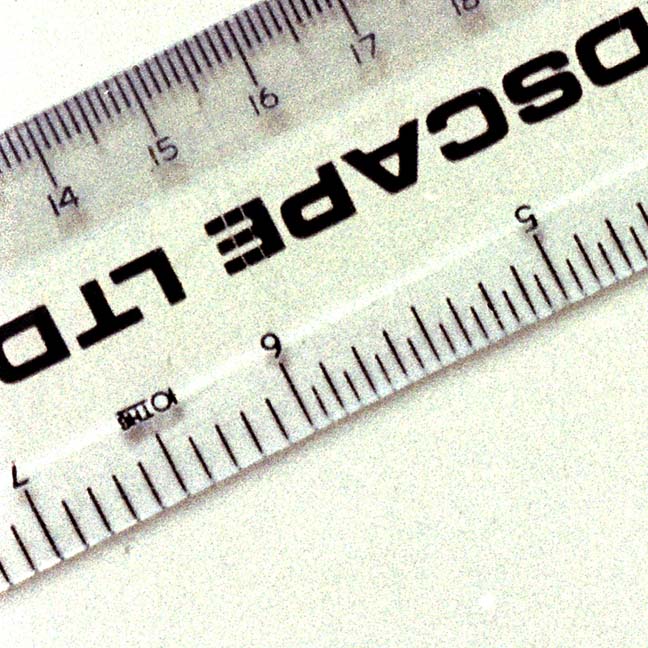 |
To see the Exakta 66 bellows, click here.
To go back to the beginning of the macro section, click here.
To go on to the next section, click below.
Next section (using the macro lenses on
the Pentacon Six bellows)
© TRA July 2006, September 2009